Comprehensive Income Tax Calculation and Relevant Laws Applied
VerifiedAdded on 2021/05/31
|11
|2496
|29
Homework Assignment
AI Summary
This homework assignment provides a detailed analysis of Australian income tax calculations. The solution covers various scenarios including calculating tax payable for individuals (residents and non-residents) and companies with different income levels. It explores the application of relevant tax brackets, medical levies, and surcharges. The assignment also delves into the taxation of dividend income, considering both franked and unfranked dividends, along with imputation franking credits. The solution includes calculations for PAYG tax, allowable deductions, and the impact of medical levies and surcharges on different income levels and residency statuses. Furthermore, the assignment provides a breakdown of tax liabilities and refunds, offering a comprehensive understanding of the Australian tax system. The assignment also includes a reference list of sources consulted.
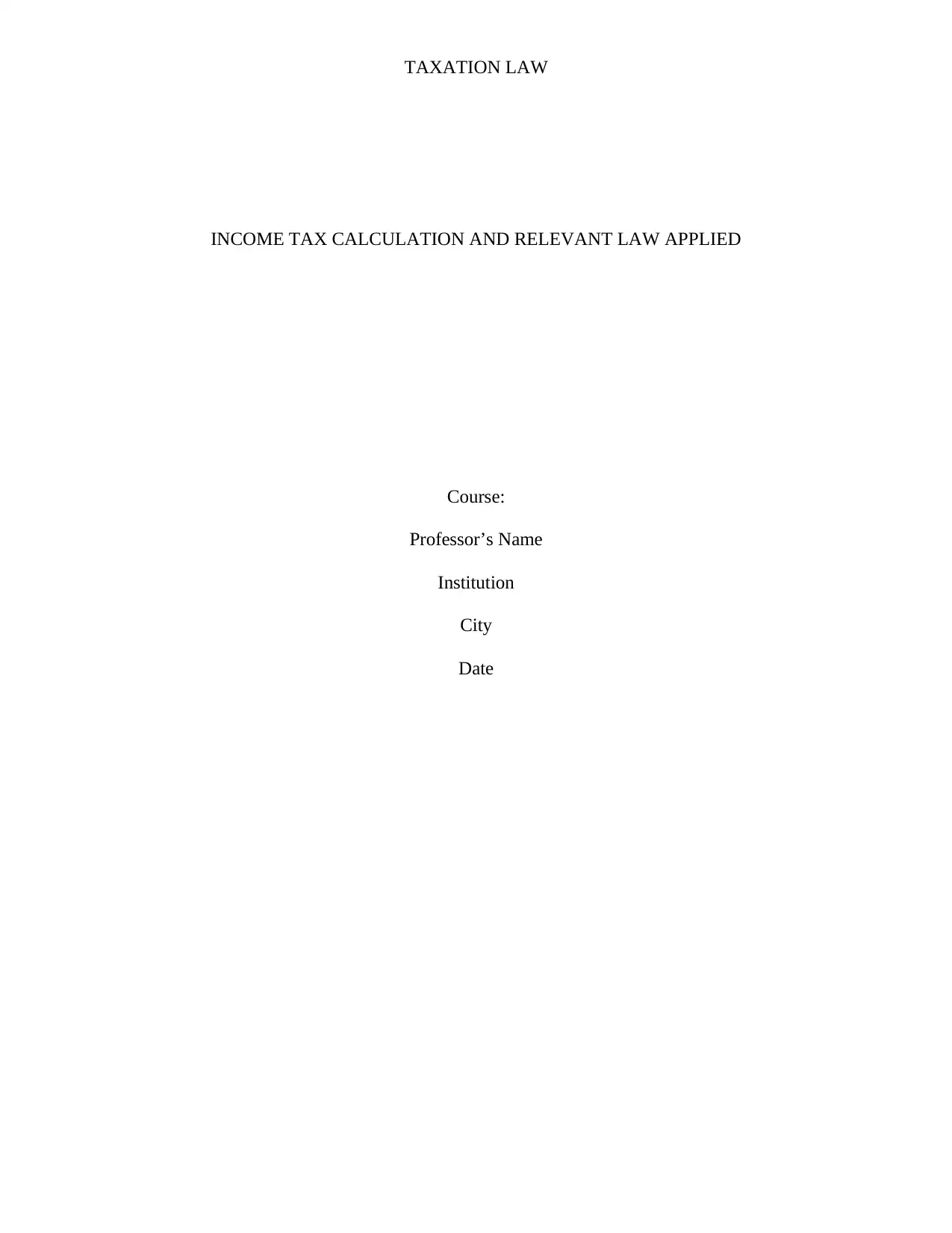
TAXATION LAW
INCOME TAX CALCULATION AND RELEVANT LAW APPLIED
Course:
Professor’s Name
Institution
City
Date
INCOME TAX CALCULATION AND RELEVANT LAW APPLIED
Course:
Professor’s Name
Institution
City
Date
Paraphrase This Document
Need a fresh take? Get an instant paraphrase of this document with our AI Paraphraser
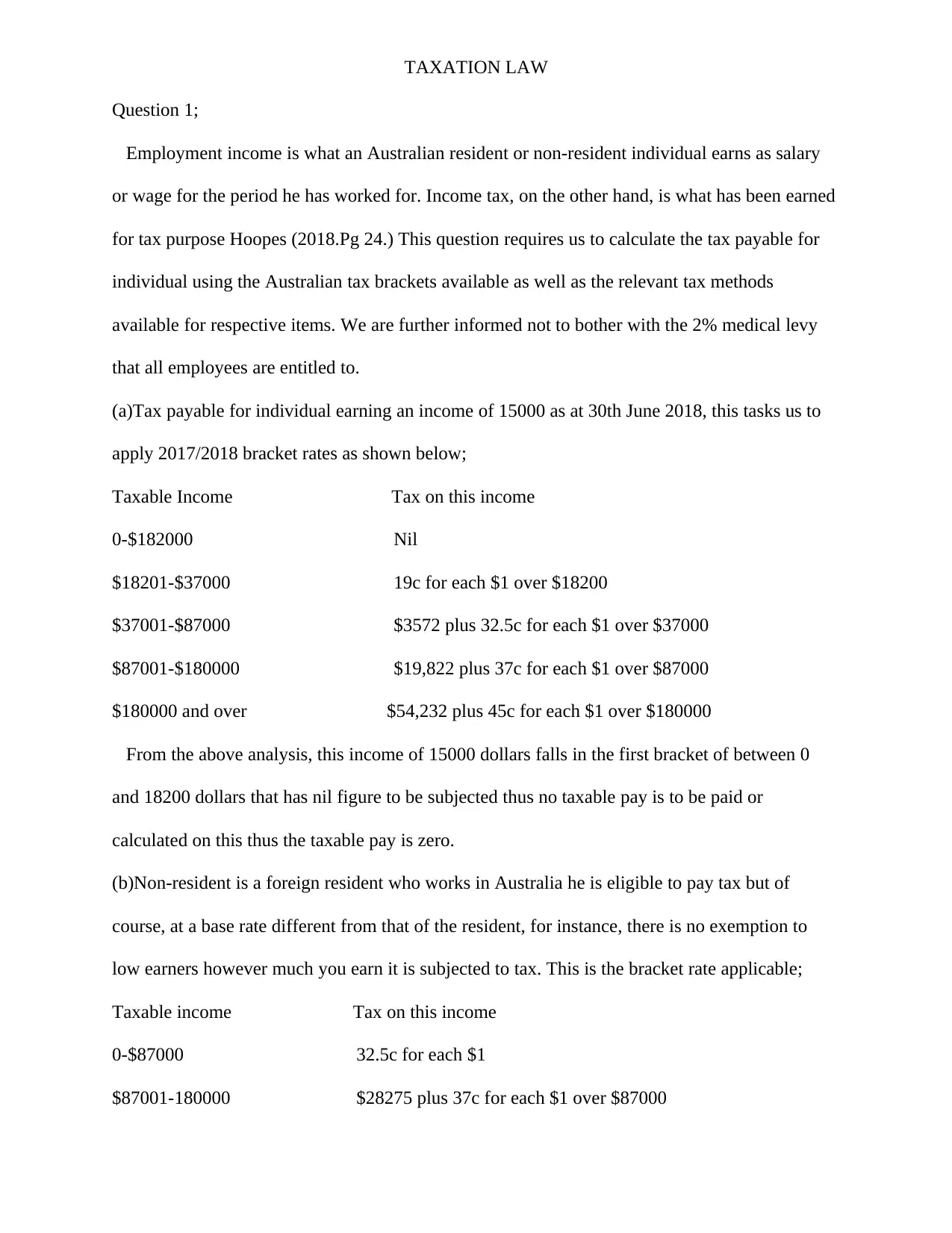
TAXATION LAW
Question 1;
Employment income is what an Australian resident or non-resident individual earns as salary
or wage for the period he has worked for. Income tax, on the other hand, is what has been earned
for tax purpose Hoopes (2018.Pg 24.) This question requires us to calculate the tax payable for
individual using the Australian tax brackets available as well as the relevant tax methods
available for respective items. We are further informed not to bother with the 2% medical levy
that all employees are entitled to.
(a)Tax payable for individual earning an income of 15000 as at 30th June 2018, this tasks us to
apply 2017/2018 bracket rates as shown below;
Taxable Income Tax on this income
0-$182000 Nil
$18201-$37000 19c for each $1 over $18200
$37001-$87000 $3572 plus 32.5c for each $1 over $37000
$87001-$180000 $19,822 plus 37c for each $1 over $87000
$180000 and over $54,232 plus 45c for each $1 over $180000
From the above analysis, this income of 15000 dollars falls in the first bracket of between 0
and 18200 dollars that has nil figure to be subjected thus no taxable pay is to be paid or
calculated on this thus the taxable pay is zero.
(b)Non-resident is a foreign resident who works in Australia he is eligible to pay tax but of
course, at a base rate different from that of the resident, for instance, there is no exemption to
low earners however much you earn it is subjected to tax. This is the bracket rate applicable;
Taxable income Tax on this income
0-$87000 32.5c for each $1
$87001-180000 $28275 plus 37c for each $1 over $87000
Question 1;
Employment income is what an Australian resident or non-resident individual earns as salary
or wage for the period he has worked for. Income tax, on the other hand, is what has been earned
for tax purpose Hoopes (2018.Pg 24.) This question requires us to calculate the tax payable for
individual using the Australian tax brackets available as well as the relevant tax methods
available for respective items. We are further informed not to bother with the 2% medical levy
that all employees are entitled to.
(a)Tax payable for individual earning an income of 15000 as at 30th June 2018, this tasks us to
apply 2017/2018 bracket rates as shown below;
Taxable Income Tax on this income
0-$182000 Nil
$18201-$37000 19c for each $1 over $18200
$37001-$87000 $3572 plus 32.5c for each $1 over $37000
$87001-$180000 $19,822 plus 37c for each $1 over $87000
$180000 and over $54,232 plus 45c for each $1 over $180000
From the above analysis, this income of 15000 dollars falls in the first bracket of between 0
and 18200 dollars that has nil figure to be subjected thus no taxable pay is to be paid or
calculated on this thus the taxable pay is zero.
(b)Non-resident is a foreign resident who works in Australia he is eligible to pay tax but of
course, at a base rate different from that of the resident, for instance, there is no exemption to
low earners however much you earn it is subjected to tax. This is the bracket rate applicable;
Taxable income Tax on this income
0-$87000 32.5c for each $1
$87001-180000 $28275 plus 37c for each $1 over $87000
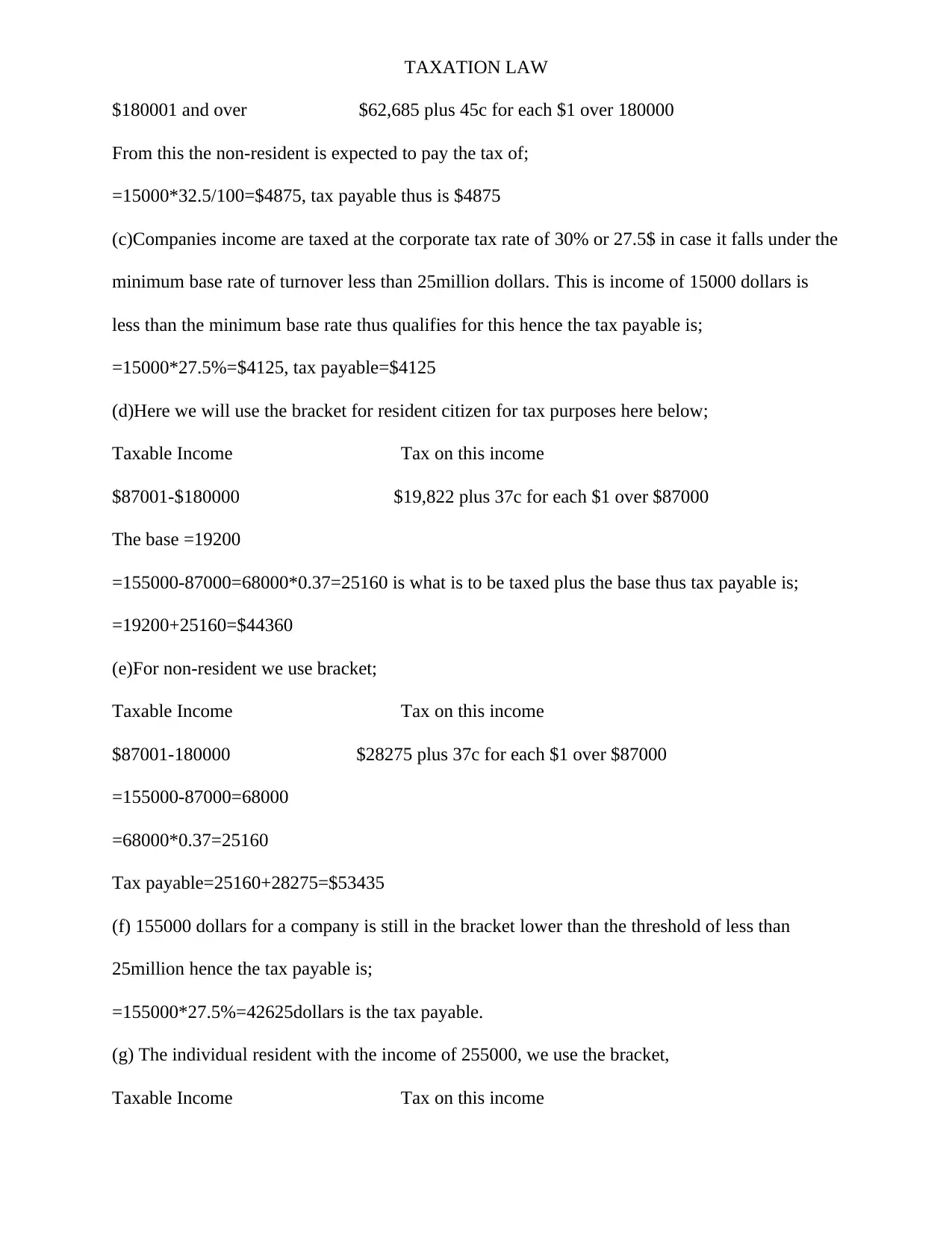
TAXATION LAW
$180001 and over $62,685 plus 45c for each $1 over 180000
From this the non-resident is expected to pay the tax of;
=15000*32.5/100=$4875, tax payable thus is $4875
(c)Companies income are taxed at the corporate tax rate of 30% or 27.5$ in case it falls under the
minimum base rate of turnover less than 25million dollars. This is income of 15000 dollars is
less than the minimum base rate thus qualifies for this hence the tax payable is;
=15000*27.5%=$4125, tax payable=$4125
(d)Here we will use the bracket for resident citizen for tax purposes here below;
Taxable Income Tax on this income
$87001-$180000 $19,822 plus 37c for each $1 over $87000
The base =19200
=155000-87000=68000*0.37=25160 is what is to be taxed plus the base thus tax payable is;
=19200+25160=$44360
(e)For non-resident we use bracket;
Taxable Income Tax on this income
$87001-180000 $28275 plus 37c for each $1 over $87000
=155000-87000=68000
=68000*0.37=25160
Tax payable=25160+28275=$53435
(f) 155000 dollars for a company is still in the bracket lower than the threshold of less than
25million hence the tax payable is;
=155000*27.5%=42625dollars is the tax payable.
(g) The individual resident with the income of 255000, we use the bracket,
Taxable Income Tax on this income
$180001 and over $62,685 plus 45c for each $1 over 180000
From this the non-resident is expected to pay the tax of;
=15000*32.5/100=$4875, tax payable thus is $4875
(c)Companies income are taxed at the corporate tax rate of 30% or 27.5$ in case it falls under the
minimum base rate of turnover less than 25million dollars. This is income of 15000 dollars is
less than the minimum base rate thus qualifies for this hence the tax payable is;
=15000*27.5%=$4125, tax payable=$4125
(d)Here we will use the bracket for resident citizen for tax purposes here below;
Taxable Income Tax on this income
$87001-$180000 $19,822 plus 37c for each $1 over $87000
The base =19200
=155000-87000=68000*0.37=25160 is what is to be taxed plus the base thus tax payable is;
=19200+25160=$44360
(e)For non-resident we use bracket;
Taxable Income Tax on this income
$87001-180000 $28275 plus 37c for each $1 over $87000
=155000-87000=68000
=68000*0.37=25160
Tax payable=25160+28275=$53435
(f) 155000 dollars for a company is still in the bracket lower than the threshold of less than
25million hence the tax payable is;
=155000*27.5%=42625dollars is the tax payable.
(g) The individual resident with the income of 255000, we use the bracket,
Taxable Income Tax on this income
⊘ This is a preview!⊘
Do you want full access?
Subscribe today to unlock all pages.

Trusted by 1+ million students worldwide
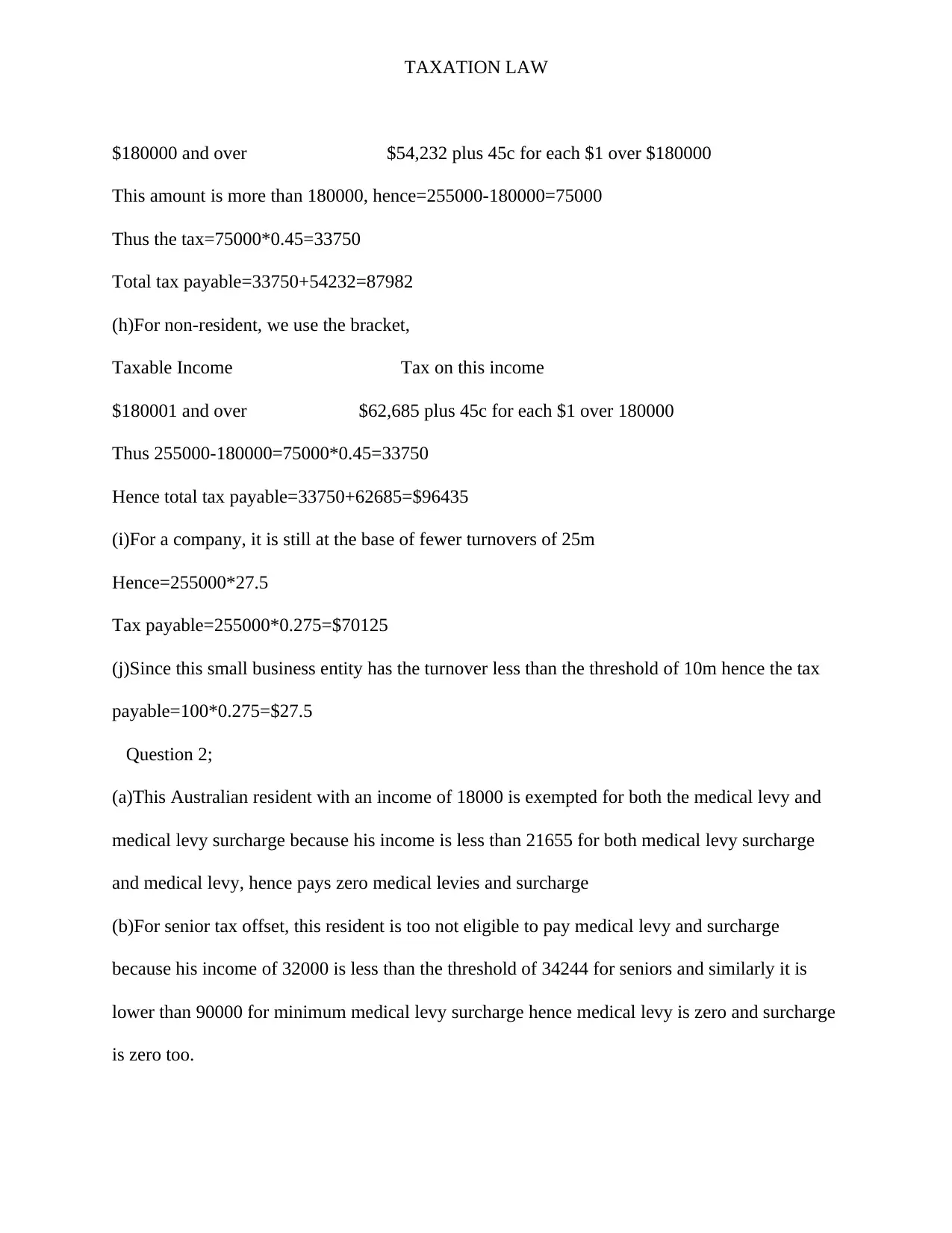
TAXATION LAW
$180000 and over $54,232 plus 45c for each $1 over $180000
This amount is more than 180000, hence=255000-180000=75000
Thus the tax=75000*0.45=33750
Total tax payable=33750+54232=87982
(h)For non-resident, we use the bracket,
Taxable Income Tax on this income
$180001 and over $62,685 plus 45c for each $1 over 180000
Thus 255000-180000=75000*0.45=33750
Hence total tax payable=33750+62685=$96435
(i)For a company, it is still at the base of fewer turnovers of 25m
Hence=255000*27.5
Tax payable=255000*0.275=$70125
(j)Since this small business entity has the turnover less than the threshold of 10m hence the tax
payable=100*0.275=$27.5
Question 2;
(a)This Australian resident with an income of 18000 is exempted for both the medical levy and
medical levy surcharge because his income is less than 21655 for both medical levy surcharge
and medical levy, hence pays zero medical levies and surcharge
(b)For senior tax offset, this resident is too not eligible to pay medical levy and surcharge
because his income of 32000 is less than the threshold of 34244 for seniors and similarly it is
lower than 90000 for minimum medical levy surcharge hence medical levy is zero and surcharge
is zero too.
$180000 and over $54,232 plus 45c for each $1 over $180000
This amount is more than 180000, hence=255000-180000=75000
Thus the tax=75000*0.45=33750
Total tax payable=33750+54232=87982
(h)For non-resident, we use the bracket,
Taxable Income Tax on this income
$180001 and over $62,685 plus 45c for each $1 over 180000
Thus 255000-180000=75000*0.45=33750
Hence total tax payable=33750+62685=$96435
(i)For a company, it is still at the base of fewer turnovers of 25m
Hence=255000*27.5
Tax payable=255000*0.275=$70125
(j)Since this small business entity has the turnover less than the threshold of 10m hence the tax
payable=100*0.275=$27.5
Question 2;
(a)This Australian resident with an income of 18000 is exempted for both the medical levy and
medical levy surcharge because his income is less than 21655 for both medical levy surcharge
and medical levy, hence pays zero medical levies and surcharge
(b)For senior tax offset, this resident is too not eligible to pay medical levy and surcharge
because his income of 32000 is less than the threshold of 34244 for seniors and similarly it is
lower than 90000 for minimum medical levy surcharge hence medical levy is zero and surcharge
is zero too.
Paraphrase This Document
Need a fresh take? Get an instant paraphrase of this document with our AI Paraphraser
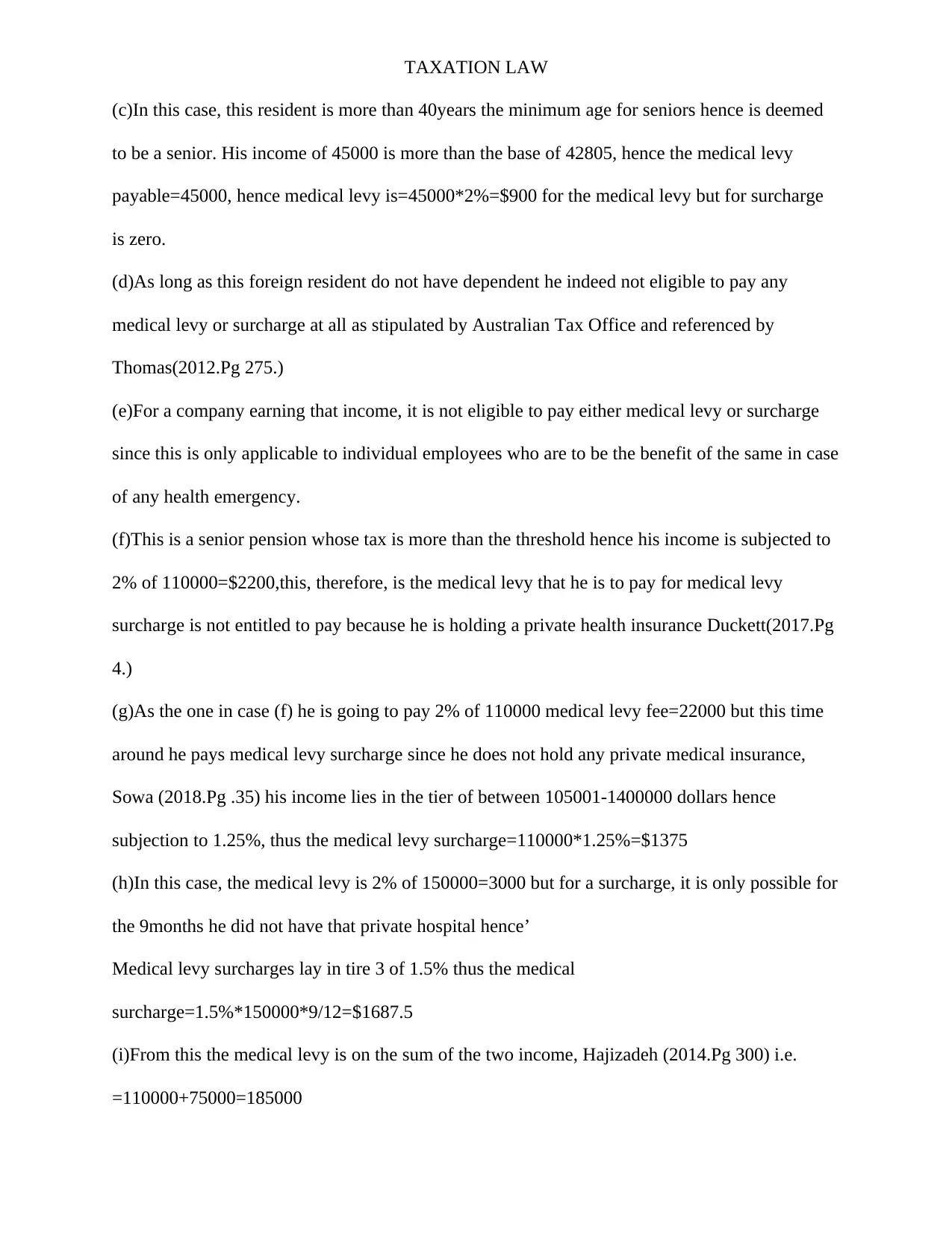
TAXATION LAW
(c)In this case, this resident is more than 40years the minimum age for seniors hence is deemed
to be a senior. His income of 45000 is more than the base of 42805, hence the medical levy
payable=45000, hence medical levy is=45000*2%=$900 for the medical levy but for surcharge
is zero.
(d)As long as this foreign resident do not have dependent he indeed not eligible to pay any
medical levy or surcharge at all as stipulated by Australian Tax Office and referenced by
Thomas(2012.Pg 275.)
(e)For a company earning that income, it is not eligible to pay either medical levy or surcharge
since this is only applicable to individual employees who are to be the benefit of the same in case
of any health emergency.
(f)This is a senior pension whose tax is more than the threshold hence his income is subjected to
2% of 110000=$2200,this, therefore, is the medical levy that he is to pay for medical levy
surcharge is not entitled to pay because he is holding a private health insurance Duckett(2017.Pg
4.)
(g)As the one in case (f) he is going to pay 2% of 110000 medical levy fee=22000 but this time
around he pays medical levy surcharge since he does not hold any private medical insurance,
Sowa (2018.Pg .35) his income lies in the tier of between 105001-1400000 dollars hence
subjection to 1.25%, thus the medical levy surcharge=110000*1.25%=$1375
(h)In this case, the medical levy is 2% of 150000=3000 but for a surcharge, it is only possible for
the 9months he did not have that private hospital hence’
Medical levy surcharges lay in tire 3 of 1.5% thus the medical
surcharge=1.5%*150000*9/12=$1687.5
(i)From this the medical levy is on the sum of the two income, Hajizadeh (2014.Pg 300) i.e.
=110000+75000=185000
(c)In this case, this resident is more than 40years the minimum age for seniors hence is deemed
to be a senior. His income of 45000 is more than the base of 42805, hence the medical levy
payable=45000, hence medical levy is=45000*2%=$900 for the medical levy but for surcharge
is zero.
(d)As long as this foreign resident do not have dependent he indeed not eligible to pay any
medical levy or surcharge at all as stipulated by Australian Tax Office and referenced by
Thomas(2012.Pg 275.)
(e)For a company earning that income, it is not eligible to pay either medical levy or surcharge
since this is only applicable to individual employees who are to be the benefit of the same in case
of any health emergency.
(f)This is a senior pension whose tax is more than the threshold hence his income is subjected to
2% of 110000=$2200,this, therefore, is the medical levy that he is to pay for medical levy
surcharge is not entitled to pay because he is holding a private health insurance Duckett(2017.Pg
4.)
(g)As the one in case (f) he is going to pay 2% of 110000 medical levy fee=22000 but this time
around he pays medical levy surcharge since he does not hold any private medical insurance,
Sowa (2018.Pg .35) his income lies in the tier of between 105001-1400000 dollars hence
subjection to 1.25%, thus the medical levy surcharge=110000*1.25%=$1375
(h)In this case, the medical levy is 2% of 150000=3000 but for a surcharge, it is only possible for
the 9months he did not have that private hospital hence’
Medical levy surcharges lay in tire 3 of 1.5% thus the medical
surcharge=1.5%*150000*9/12=$1687.5
(i)From this the medical levy is on the sum of the two income, Hajizadeh (2014.Pg 300) i.e.
=110000+75000=185000
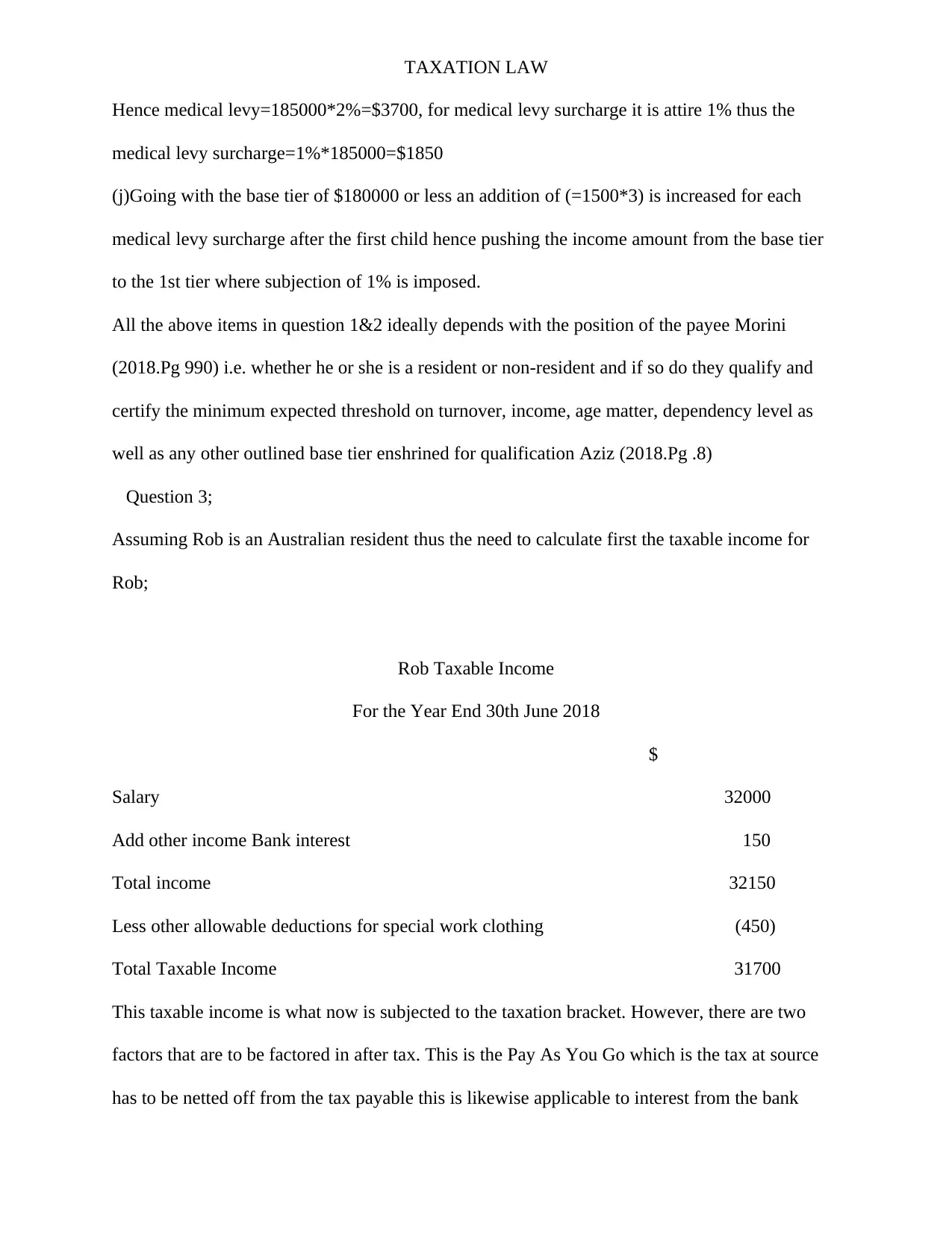
TAXATION LAW
Hence medical levy=185000*2%=$3700, for medical levy surcharge it is attire 1% thus the
medical levy surcharge=1%*185000=$1850
(j)Going with the base tier of $180000 or less an addition of (=1500*3) is increased for each
medical levy surcharge after the first child hence pushing the income amount from the base tier
to the 1st tier where subjection of 1% is imposed.
All the above items in question 1&2 ideally depends with the position of the payee Morini
(2018.Pg 990) i.e. whether he or she is a resident or non-resident and if so do they qualify and
certify the minimum expected threshold on turnover, income, age matter, dependency level as
well as any other outlined base tier enshrined for qualification Aziz (2018.Pg .8)
Question 3;
Assuming Rob is an Australian resident thus the need to calculate first the taxable income for
Rob;
Rob Taxable Income
For the Year End 30th June 2018
$
Salary 32000
Add other income Bank interest 150
Total income 32150
Less other allowable deductions for special work clothing (450)
Total Taxable Income 31700
This taxable income is what now is subjected to the taxation bracket. However, there are two
factors that are to be factored in after tax. This is the Pay As You Go which is the tax at source
has to be netted off from the tax payable this is likewise applicable to interest from the bank
Hence medical levy=185000*2%=$3700, for medical levy surcharge it is attire 1% thus the
medical levy surcharge=1%*185000=$1850
(j)Going with the base tier of $180000 or less an addition of (=1500*3) is increased for each
medical levy surcharge after the first child hence pushing the income amount from the base tier
to the 1st tier where subjection of 1% is imposed.
All the above items in question 1&2 ideally depends with the position of the payee Morini
(2018.Pg 990) i.e. whether he or she is a resident or non-resident and if so do they qualify and
certify the minimum expected threshold on turnover, income, age matter, dependency level as
well as any other outlined base tier enshrined for qualification Aziz (2018.Pg .8)
Question 3;
Assuming Rob is an Australian resident thus the need to calculate first the taxable income for
Rob;
Rob Taxable Income
For the Year End 30th June 2018
$
Salary 32000
Add other income Bank interest 150
Total income 32150
Less other allowable deductions for special work clothing (450)
Total Taxable Income 31700
This taxable income is what now is subjected to the taxation bracket. However, there are two
factors that are to be factored in after tax. This is the Pay As You Go which is the tax at source
has to be netted off from the tax payable this is likewise applicable to interest from the bank
⊘ This is a preview!⊘
Do you want full access?
Subscribe today to unlock all pages.

Trusted by 1+ million students worldwide
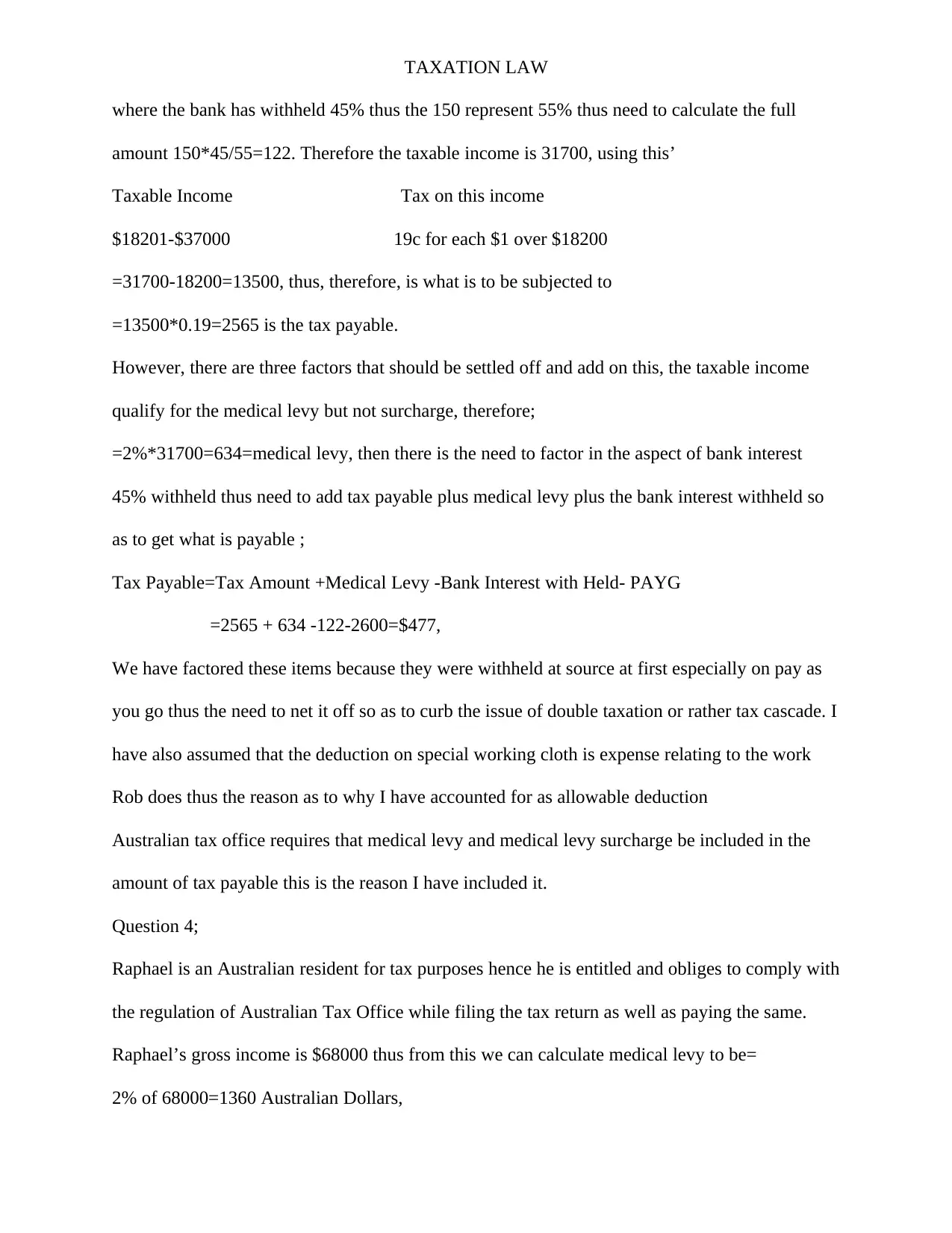
TAXATION LAW
where the bank has withheld 45% thus the 150 represent 55% thus need to calculate the full
amount 150*45/55=122. Therefore the taxable income is 31700, using this’
Taxable Income Tax on this income
$18201-$37000 19c for each $1 over $18200
=31700-18200=13500, thus, therefore, is what is to be subjected to
=13500*0.19=2565 is the tax payable.
However, there are three factors that should be settled off and add on this, the taxable income
qualify for the medical levy but not surcharge, therefore;
=2%*31700=634=medical levy, then there is the need to factor in the aspect of bank interest
45% withheld thus need to add tax payable plus medical levy plus the bank interest withheld so
as to get what is payable ;
Tax Payable=Tax Amount +Medical Levy -Bank Interest with Held- PAYG
=2565 + 634 -122-2600=$477,
We have factored these items because they were withheld at source at first especially on pay as
you go thus the need to net it off so as to curb the issue of double taxation or rather tax cascade. I
have also assumed that the deduction on special working cloth is expense relating to the work
Rob does thus the reason as to why I have accounted for as allowable deduction
Australian tax office requires that medical levy and medical levy surcharge be included in the
amount of tax payable this is the reason I have included it.
Question 4;
Raphael is an Australian resident for tax purposes hence he is entitled and obliges to comply with
the regulation of Australian Tax Office while filing the tax return as well as paying the same.
Raphael’s gross income is $68000 thus from this we can calculate medical levy to be=
2% of 68000=1360 Australian Dollars,
where the bank has withheld 45% thus the 150 represent 55% thus need to calculate the full
amount 150*45/55=122. Therefore the taxable income is 31700, using this’
Taxable Income Tax on this income
$18201-$37000 19c for each $1 over $18200
=31700-18200=13500, thus, therefore, is what is to be subjected to
=13500*0.19=2565 is the tax payable.
However, there are three factors that should be settled off and add on this, the taxable income
qualify for the medical levy but not surcharge, therefore;
=2%*31700=634=medical levy, then there is the need to factor in the aspect of bank interest
45% withheld thus need to add tax payable plus medical levy plus the bank interest withheld so
as to get what is payable ;
Tax Payable=Tax Amount +Medical Levy -Bank Interest with Held- PAYG
=2565 + 634 -122-2600=$477,
We have factored these items because they were withheld at source at first especially on pay as
you go thus the need to net it off so as to curb the issue of double taxation or rather tax cascade. I
have also assumed that the deduction on special working cloth is expense relating to the work
Rob does thus the reason as to why I have accounted for as allowable deduction
Australian tax office requires that medical levy and medical levy surcharge be included in the
amount of tax payable this is the reason I have included it.
Question 4;
Raphael is an Australian resident for tax purposes hence he is entitled and obliges to comply with
the regulation of Australian Tax Office while filing the tax return as well as paying the same.
Raphael’s gross income is $68000 thus from this we can calculate medical levy to be=
2% of 68000=1360 Australian Dollars,
Paraphrase This Document
Need a fresh take? Get an instant paraphrase of this document with our AI Paraphraser
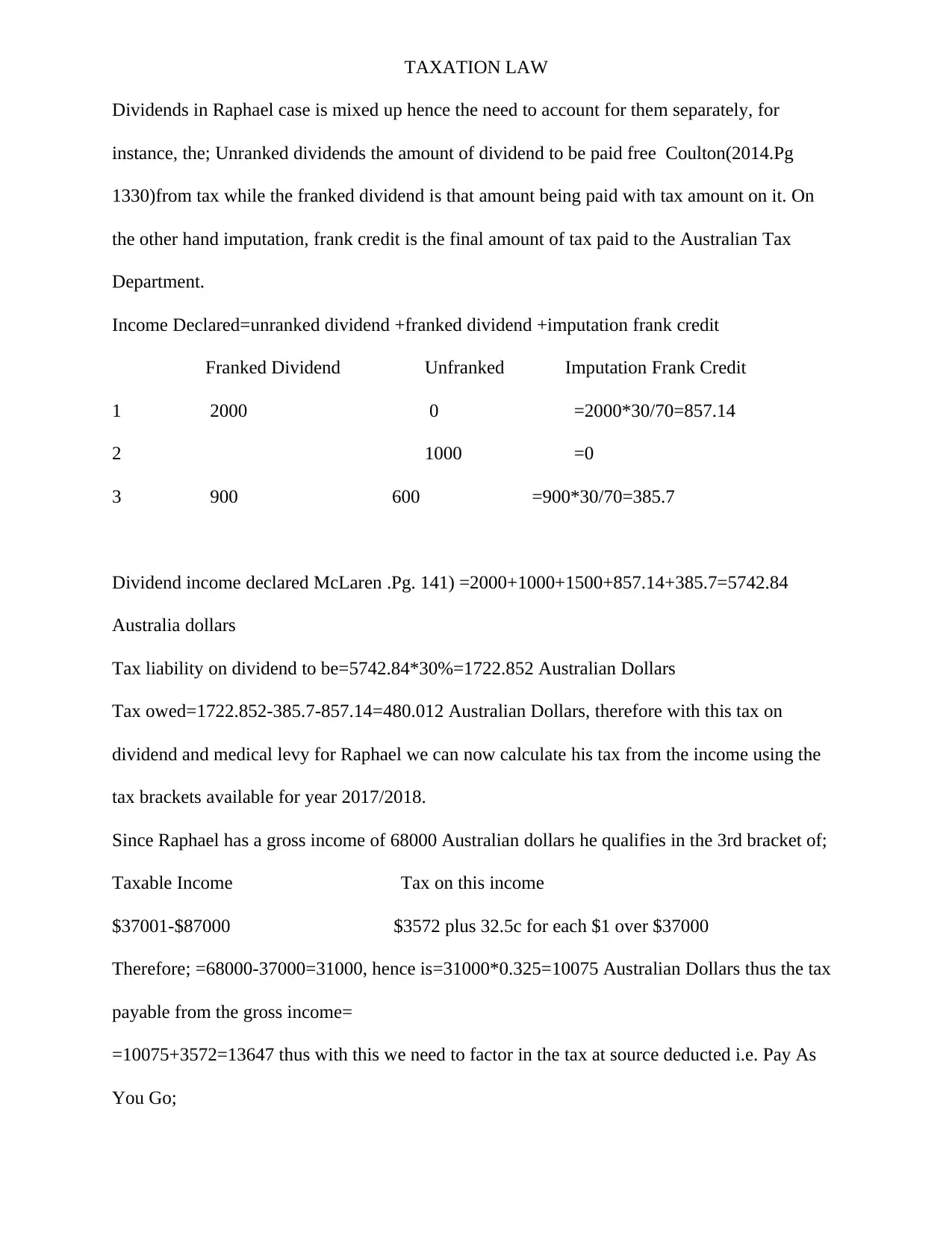
TAXATION LAW
Dividends in Raphael case is mixed up hence the need to account for them separately, for
instance, the; Unranked dividends the amount of dividend to be paid free Coulton(2014.Pg
1330)from tax while the franked dividend is that amount being paid with tax amount on it. On
the other hand imputation, frank credit is the final amount of tax paid to the Australian Tax
Department.
Income Declared=unranked dividend +franked dividend +imputation frank credit
Franked Dividend Unfranked Imputation Frank Credit
1 2000 0 =2000*30/70=857.14
2 1000 =0
3 900 600 =900*30/70=385.7
Dividend income declared McLaren .Pg. 141) =2000+1000+1500+857.14+385.7=5742.84
Australia dollars
Tax liability on dividend to be=5742.84*30%=1722.852 Australian Dollars
Tax owed=1722.852-385.7-857.14=480.012 Australian Dollars, therefore with this tax on
dividend and medical levy for Raphael we can now calculate his tax from the income using the
tax brackets available for year 2017/2018.
Since Raphael has a gross income of 68000 Australian dollars he qualifies in the 3rd bracket of;
Taxable Income Tax on this income
$37001-$87000 $3572 plus 32.5c for each $1 over $37000
Therefore; =68000-37000=31000, hence is=31000*0.325=10075 Australian Dollars thus the tax
payable from the gross income=
=10075+3572=13647 thus with this we need to factor in the tax at source deducted i.e. Pay As
You Go;
Dividends in Raphael case is mixed up hence the need to account for them separately, for
instance, the; Unranked dividends the amount of dividend to be paid free Coulton(2014.Pg
1330)from tax while the franked dividend is that amount being paid with tax amount on it. On
the other hand imputation, frank credit is the final amount of tax paid to the Australian Tax
Department.
Income Declared=unranked dividend +franked dividend +imputation frank credit
Franked Dividend Unfranked Imputation Frank Credit
1 2000 0 =2000*30/70=857.14
2 1000 =0
3 900 600 =900*30/70=385.7
Dividend income declared McLaren .Pg. 141) =2000+1000+1500+857.14+385.7=5742.84
Australia dollars
Tax liability on dividend to be=5742.84*30%=1722.852 Australian Dollars
Tax owed=1722.852-385.7-857.14=480.012 Australian Dollars, therefore with this tax on
dividend and medical levy for Raphael we can now calculate his tax from the income using the
tax brackets available for year 2017/2018.
Since Raphael has a gross income of 68000 Australian dollars he qualifies in the 3rd bracket of;
Taxable Income Tax on this income
$37001-$87000 $3572 plus 32.5c for each $1 over $37000
Therefore; =68000-37000=31000, hence is=31000*0.325=10075 Australian Dollars thus the tax
payable from the gross income=
=10075+3572=13647 thus with this we need to factor in the tax at source deducted i.e. Pay As
You Go;
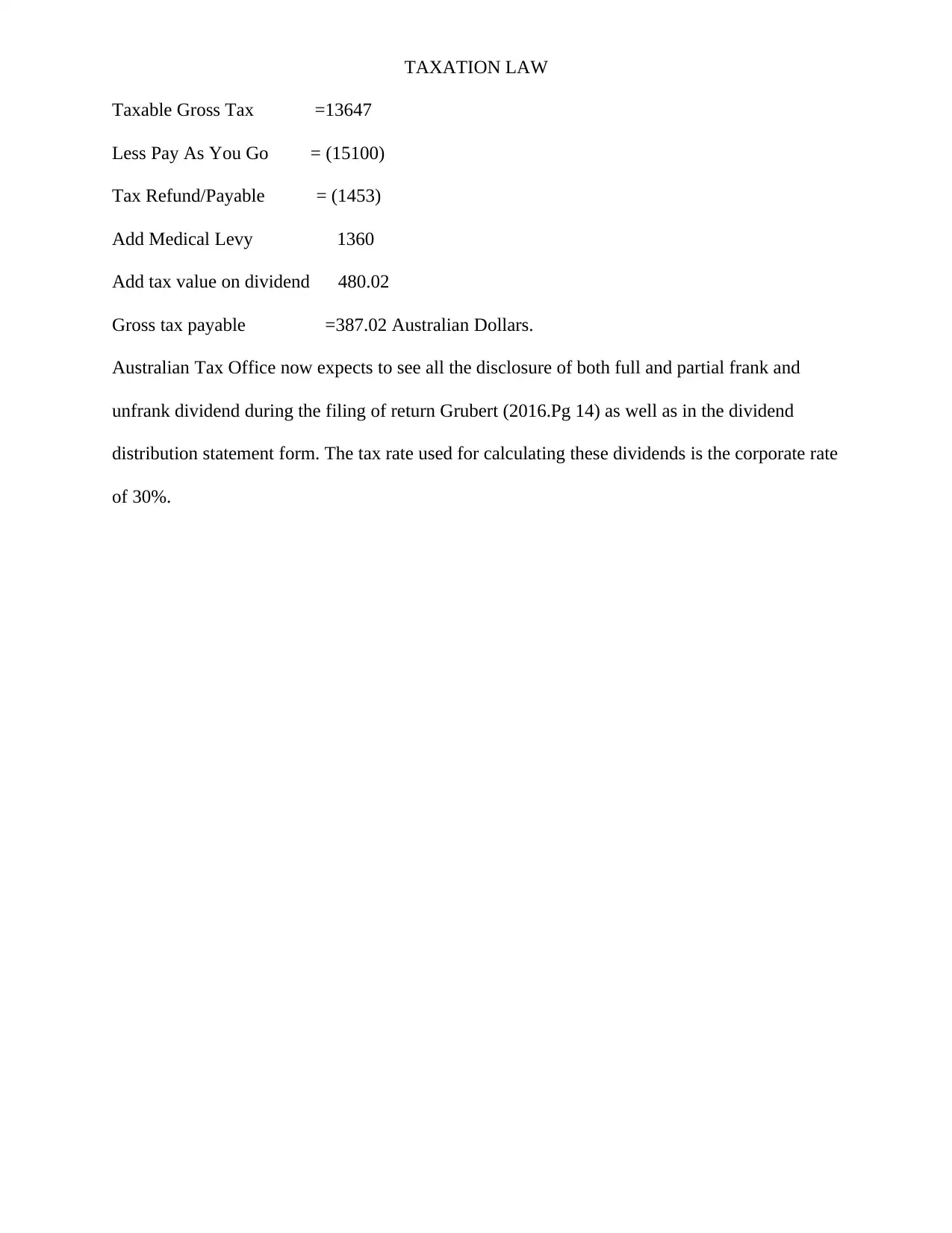
TAXATION LAW
Taxable Gross Tax =13647
Less Pay As You Go = (15100)
Tax Refund/Payable = (1453)
Add Medical Levy 1360
Add tax value on dividend 480.02
Gross tax payable =387.02 Australian Dollars.
Australian Tax Office now expects to see all the disclosure of both full and partial frank and
unfrank dividend during the filing of return Grubert (2016.Pg 14) as well as in the dividend
distribution statement form. The tax rate used for calculating these dividends is the corporate rate
of 30%.
Taxable Gross Tax =13647
Less Pay As You Go = (15100)
Tax Refund/Payable = (1453)
Add Medical Levy 1360
Add tax value on dividend 480.02
Gross tax payable =387.02 Australian Dollars.
Australian Tax Office now expects to see all the disclosure of both full and partial frank and
unfrank dividend during the filing of return Grubert (2016.Pg 14) as well as in the dividend
distribution statement form. The tax rate used for calculating these dividends is the corporate rate
of 30%.
⊘ This is a preview!⊘
Do you want full access?
Subscribe today to unlock all pages.

Trusted by 1+ million students worldwide
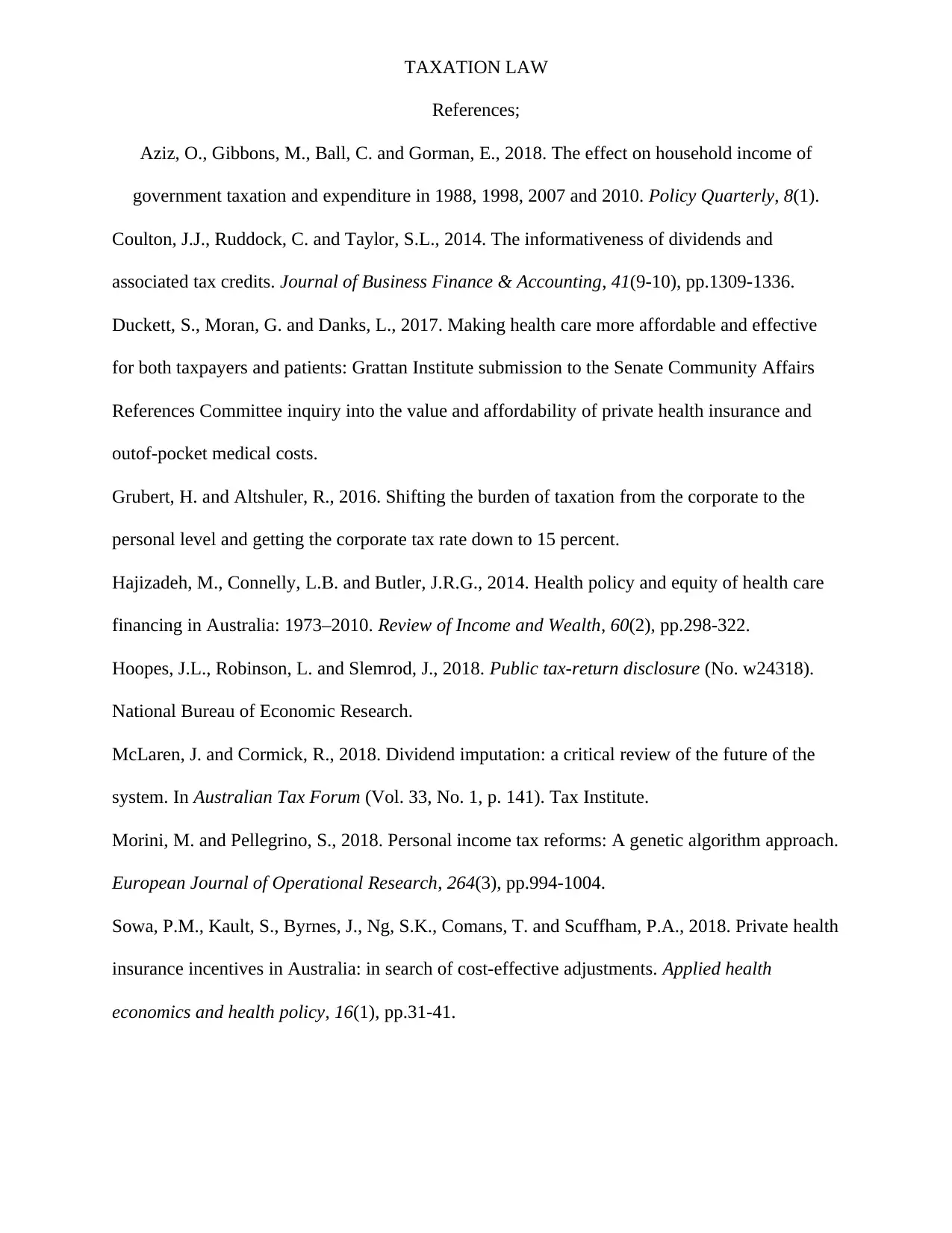
TAXATION LAW
References;
Aziz, O., Gibbons, M., Ball, C. and Gorman, E., 2018. The effect on household income of
government taxation and expenditure in 1988, 1998, 2007 and 2010. Policy Quarterly, 8(1).
Coulton, J.J., Ruddock, C. and Taylor, S.L., 2014. The informativeness of dividends and
associated tax credits. Journal of Business Finance & Accounting, 41(9-10), pp.1309-1336.
Duckett, S., Moran, G. and Danks, L., 2017. Making health care more affordable and effective
for both taxpayers and patients: Grattan Institute submission to the Senate Community Affairs
References Committee inquiry into the value and affordability of private health insurance and
outof-pocket medical costs.
Grubert, H. and Altshuler, R., 2016. Shifting the burden of taxation from the corporate to the
personal level and getting the corporate tax rate down to 15 percent.
Hajizadeh, M., Connelly, L.B. and Butler, J.R.G., 2014. Health policy and equity of health care
financing in Australia: 1973–2010. Review of Income and Wealth, 60(2), pp.298-322.
Hoopes, J.L., Robinson, L. and Slemrod, J., 2018. Public tax-return disclosure (No. w24318).
National Bureau of Economic Research.
McLaren, J. and Cormick, R., 2018. Dividend imputation: a critical review of the future of the
system. In Australian Tax Forum (Vol. 33, No. 1, p. 141). Tax Institute.
Morini, M. and Pellegrino, S., 2018. Personal income tax reforms: A genetic algorithm approach.
European Journal of Operational Research, 264(3), pp.994-1004.
Sowa, P.M., Kault, S., Byrnes, J., Ng, S.K., Comans, T. and Scuffham, P.A., 2018. Private health
insurance incentives in Australia: in search of cost-effective adjustments. Applied health
economics and health policy, 16(1), pp.31-41.
References;
Aziz, O., Gibbons, M., Ball, C. and Gorman, E., 2018. The effect on household income of
government taxation and expenditure in 1988, 1998, 2007 and 2010. Policy Quarterly, 8(1).
Coulton, J.J., Ruddock, C. and Taylor, S.L., 2014. The informativeness of dividends and
associated tax credits. Journal of Business Finance & Accounting, 41(9-10), pp.1309-1336.
Duckett, S., Moran, G. and Danks, L., 2017. Making health care more affordable and effective
for both taxpayers and patients: Grattan Institute submission to the Senate Community Affairs
References Committee inquiry into the value and affordability of private health insurance and
outof-pocket medical costs.
Grubert, H. and Altshuler, R., 2016. Shifting the burden of taxation from the corporate to the
personal level and getting the corporate tax rate down to 15 percent.
Hajizadeh, M., Connelly, L.B. and Butler, J.R.G., 2014. Health policy and equity of health care
financing in Australia: 1973–2010. Review of Income and Wealth, 60(2), pp.298-322.
Hoopes, J.L., Robinson, L. and Slemrod, J., 2018. Public tax-return disclosure (No. w24318).
National Bureau of Economic Research.
McLaren, J. and Cormick, R., 2018. Dividend imputation: a critical review of the future of the
system. In Australian Tax Forum (Vol. 33, No. 1, p. 141). Tax Institute.
Morini, M. and Pellegrino, S., 2018. Personal income tax reforms: A genetic algorithm approach.
European Journal of Operational Research, 264(3), pp.994-1004.
Sowa, P.M., Kault, S., Byrnes, J., Ng, S.K., Comans, T. and Scuffham, P.A., 2018. Private health
insurance incentives in Australia: in search of cost-effective adjustments. Applied health
economics and health policy, 16(1), pp.31-41.
Paraphrase This Document
Need a fresh take? Get an instant paraphrase of this document with our AI Paraphraser
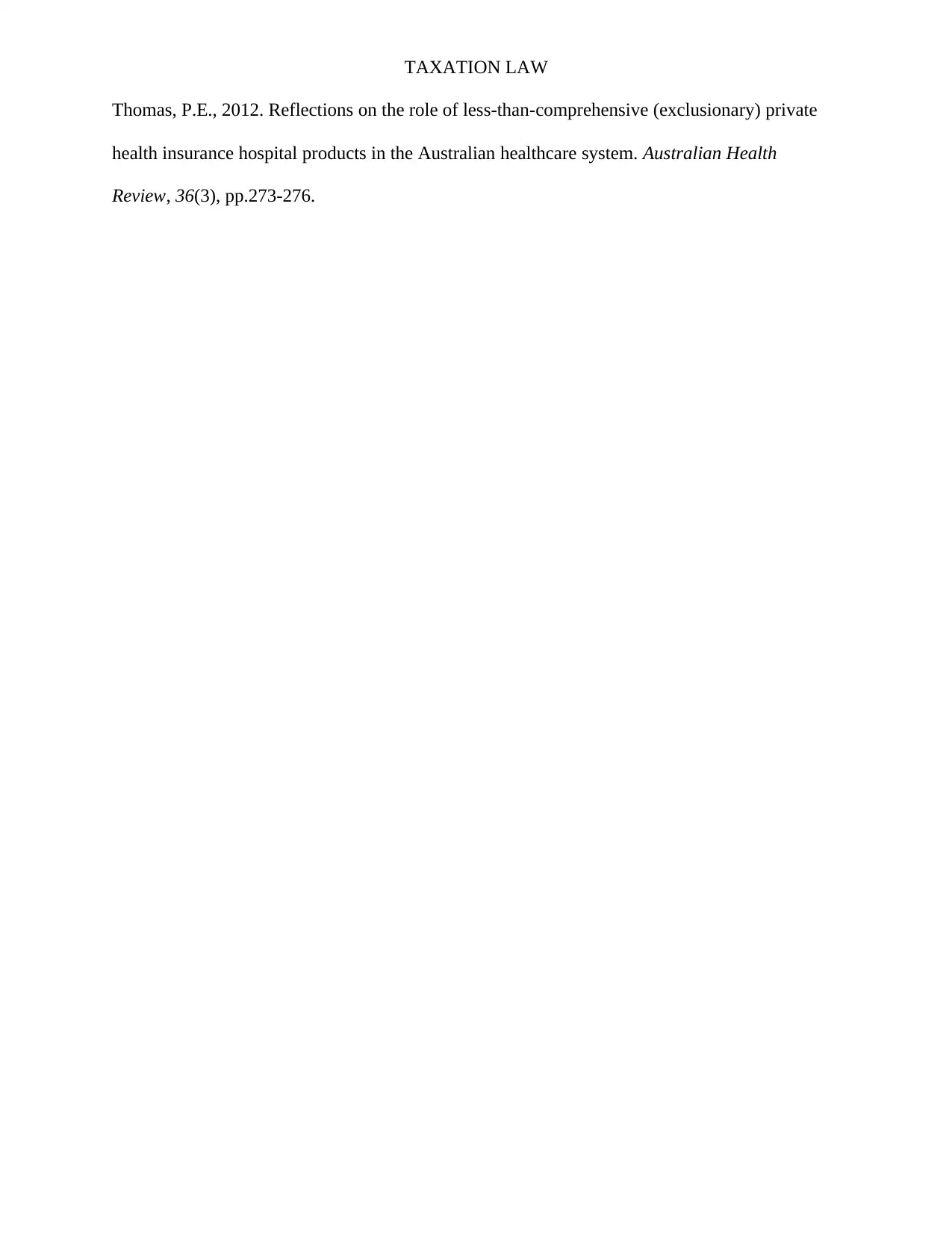
TAXATION LAW
Thomas, P.E., 2012. Reflections on the role of less-than-comprehensive (exclusionary) private
health insurance hospital products in the Australian healthcare system. Australian Health
Review, 36(3), pp.273-276.
Thomas, P.E., 2012. Reflections on the role of less-than-comprehensive (exclusionary) private
health insurance hospital products in the Australian healthcare system. Australian Health
Review, 36(3), pp.273-276.
1 out of 11
Related Documents
Your All-in-One AI-Powered Toolkit for Academic Success.
+13062052269
info@desklib.com
Available 24*7 on WhatsApp / Email
![[object Object]](/_next/static/media/star-bottom.7253800d.svg)
Unlock your academic potential
Copyright © 2020–2025 A2Z Services. All Rights Reserved. Developed and managed by ZUCOL.





